Distinguished Critique: Jimmy Olsen: Adventures by Jack Kirby (vol. 1) Review
Occasionally and awkwardly presenting dated material, these issues nevertheless display unfettered earnestness and creativity from a master storyteller
—by Nathan on September 22, 2025—
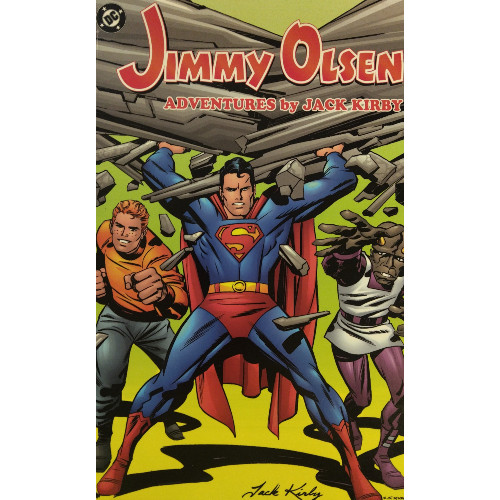
"THE GREAT ONE IS COMING!"
So blared DC Comics house ads in 1970. "The word from high is…" begins the advertisement, with the dramatic declaration beneath it, in bold, red and yellow letters, set within white cascading light against the backdrop of a blue sky, as if God himself were making the declaration. No religiosity was imbued within the ad, however, despite it looking like a dramatic Second Coming claim. The "Great One" referred to in this ad may have seemed god-like to many, but he was ultimately a king.
Jack "King" Kirby.
For those fans aware of their comics history, they know that Kirby, co-creator of the Fantastic Four, the Hulk, the X-Men, and many other Marvel characters, left the House of Ideas in 1970, for multiple reasons. His contract, to be renewed early that year, did not offer a higher page rate but did offer other unsettling terms; he was 52 years old and had recently moved his family from New York to California; he wasn't receiving nearly the level of attention or acclaim he felt was owed him, his hand in Marvel's achievements and creations during the 60s overshadowed by the self-aggrandizing attitude of one Stan "The Man" Lee. Additionally, Kirby had a story he wanted to share, one which eschewed the traditional telling of superhero comics, and he felt would not be able to create such a narrative at Marvel.
So DC Comics, and Carmine Infantino, came to the rescue.
Ultimately, from what I understand, Kirby's work at DC during the time, though trumpeted before he officially started at the Distinguished Critique, would not scale the same heights of appreciation that his 60s work at Marvel did, and he would eventually return to Marvel to work on books like Black Panther, Captain America, and The Eternals. Regardless, Kirby wove a multi-series narrative at DC, introducing his "Fourth World" mythology in, perhaps, the most inauspicious book he could pick: Superman's Pal, Jimmy Olsen, the fourth best-selling Superman title DC had on the shelves.
Jimmy Olsen: Adventures by Jack Kirby
Writer: Jack Kirby
Pencilers: Jack Kirby, with Al Plastino and Murphy Anderson
Inkers: Vince Colletta and Murphy Anderson
Colorist: Unknown
Letterer: John Costanza
Issues: Superman's Pal, Jimmy Olsen #133-139 and #141
Publication Dates: October 1970, December 1970-January 1971, March 1971-April 1971, June 1971-July 1971, September 1971
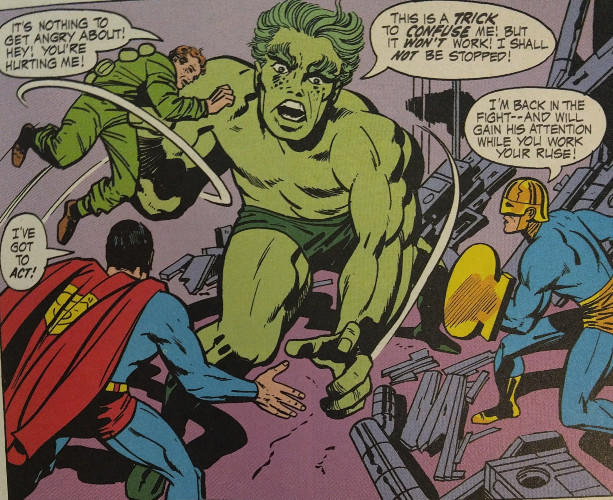
Kirby found himself working around a bit of corporate tension from the jump, as detailed in an introduction to this volume by Mark Evanier, Kirby's former production assistant and the man who would relaunch the New Gods for DC's post-Crisis universe. The DC higher-ups insisted Kirby take an existing title, whereas Kirby wanted to hit the ground running with new material, so the King compromised; he would take an established title–one, it's been noted, that didn't have a regular writer and artist assigned to it already–but he would be darn sure to make the book his own as much as he could.
With that in mind, I found I appreciated this volume, dated as the stories may be at times, for how well it represents that synergy between corporate demands and Kirby's own vision. Like at Marvel, Kirby played to the whims of other people, but you can also see his creativity at work here, as well as the promise of grander stories to come. Kirby picks up this poorly selling title–Evanier describes Jimmy Olsen as "fast closing in" on the dubious honor of being DC's worst-selling book at the time–and possesses the freedom to weave a story to his own tune. It's not like he could do anything to make it sell worse!
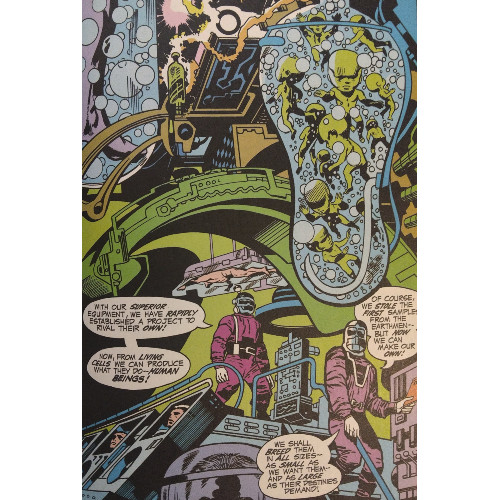
I have no idea what happened in the title before Kirby took over, but under the King, Jimmy Olsen is immediately drawn into a larger narrative alongside some other characters, mainly the Newsboy Legion and the Guardian, Kirby had invented with Captain America co-creator Joe Simon during an earlier stint at DC. Yes, the story is dated, kind of hokey, but there is pure passion here, with Kirby doing his absolute best to make something out of this bottom-of-the-barrel series. Forget your "flavor-of-the-month" standalone stories with one-off villains and easily resolved conflicts; Kirby is already building to a grander story in this volume. To that end, he introduces a hidden society of peaceniks living in a city made from trees of a fallen forest who zoom around a dangerous highway on motorcycles; a group of wild hair hippies who ride around in a massive missile carrier; and an underground organization dedicated to broadening human capability through cloning and other molecular modification projects.
Kirby does all this because he can, and before we get to how well the narrative holds up, I do wish to mention that all these elements work to a certain extent. Jimmy Olsen could all feel like an irregular mishmash of concepts, tossed together in a jumbled salad of contrary ideas that grate against each other and make for an annoying story. But they don't! I didn't frown at this the way I would at other narratives of the era which throw in so many random pieces and hope they somehow stick together. There's an earnestness here which makes the ideas purely enjoyable, even if some readers may not find the sudden appearance of an underground society of hippies a few miles outside Metropolis the most believable story conceit.
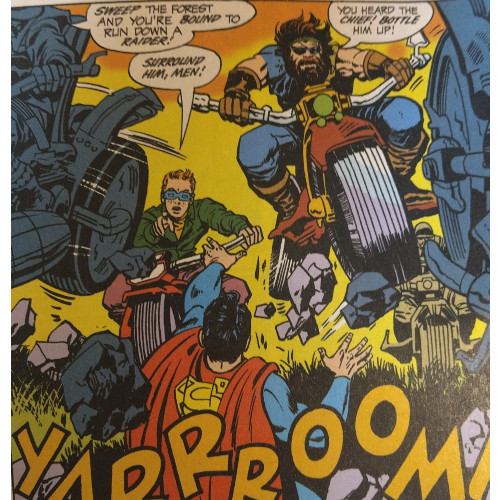
Narratively, Kirby tosses in a few nods to his larger schemes–Darkseid's face appears on a monitor during a discussion with his minion Morgan Edge, and two of Darkseid's lackeys plot against our heroes–but those are largely teases, thrown in subtly enough to not distract but pique the reader's attention in a "Like this? Read more!" sort of way. But these issues are more based around internal storytelling, focused on Superman's pal and the Man of Steel himself. Kirby wisely keeps Superman in a quasi-supporting cast role, allowing Jimmy enough focus and agency to make the book feel more than just a Superman spinoff. Conflict is nicely sewn between the two which represents Kirby's vision for the title: a book focused on the youth of the age and their unorthodox contributions to then-modern society.
Kirby had been working so long in traditional superhero comics that it seems he wanted a change, and with these first several issues, he endeavors to create a polemic about the generation gap. Jimmy Olsen and the Newsboy Legion–introduced here as the sons of the original Legion Kirby co-created in the 1940s–just want to be treated fairly, not like kids, sidekicks, or even the "pals" of a popular superhero. They want to be taken seriously, contribute to saving the day, and have an impact on the adventures of the adults around them. That the current Legion are children of the original group adds to the notion–they are, in striking ways, "copies" of their fathers, but they're still different, unique to themselves.
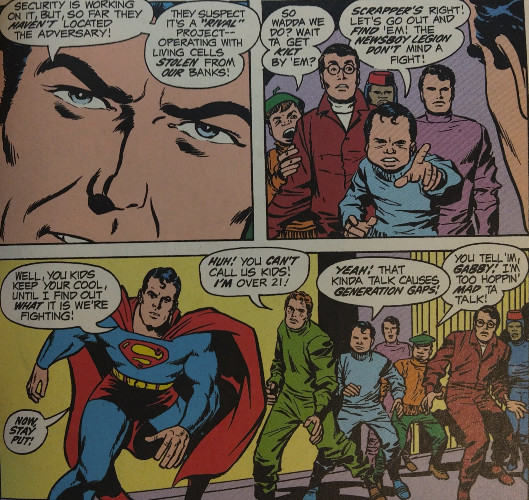
The concept of identity, specifically identity separate from what the masses or powers-that-be have determined, filters through these issues, and you can't help but wonder if this is Kirby knocking his superiors at Marvel somewhat (a much more obvious statement would be made with the debut of Funky Flashman in Mister Miracle, but we'll take the subtlety here). The Legion boys don't want to be treated like kids, and the beatnik Wild Bunch and the hippie Hairies have developed their own civilizations separate from the larger outside world. Kirby writes this material knowing what it's like to have someone put you in a bottle, define who you are and what you do for them. If anything else, his less-than-favorable contract renewal at Marvel was an indication of such treatment, and you can feel Kirby thumbing his nose at certain established authorities in these stories. These characters may be framed as stand-ins for protesting people groups of the time, but that's just a clever method of appealing to youngsters while Kirby makes sure his heart is poured into these stories.
That spirit makes some of the artistic choices all the more amusing, because while Kirby illustrates these stories, his vision for certain characters–specifically Superman and Jimmy Olsen–didn't jive with the higher-ups. So while Kirby is writing about breaking free from societal constraints, DC head honchos instructed Al Plastino and Murphy Anderson to redraw Superman and Jimmy's faces to align with accepted figure designs, notably those of famous Superman illustrator Curt Swan. If you read these stories without knowing that tidbit, Superman and Jimmy aren't terribly distracting, but once you know…man, is it difficult to unsee (and I do apologize for mentioning it for the reader who picks up this collection relatively blindly). The rest of the art in these issues is pure Kirby, but seeing Jimmy and Superman's faces drawn by other illustrators makes me wonder what Kirby's designs for them would have been. Evanier notes in the intro that Kirby dutifully drew their faces in his own style even knowing they would be changed later, so good for him, honestly. I just wish DC had been less confining with the designs.
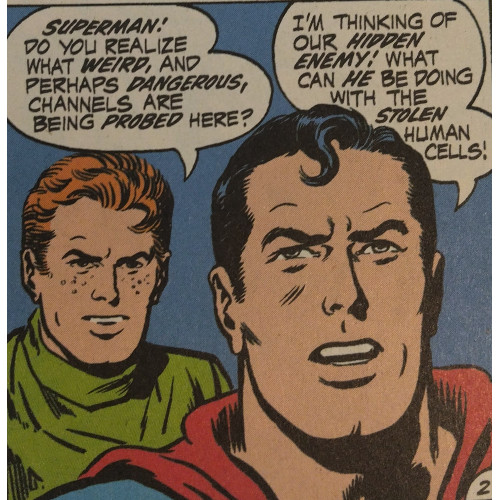
Elsewhere, Kirby commands the rest of the art, and his illustrations are as weird and wonderful as any reader would hope while feeling intentionally used in telling Kirby's story. He designs an alien considered to be the next step in molecular evolution, a creature not too dissimilar from a "future man" he'd later introduce in Black Panther. Miniature clones fly around in small planes and parachute as soldiers, allowing for a fun visual sequence. A six-armed monster becomes an adversary for the most tense issues, creating a race against time for Superman and the Legion as they try to prevent the monster from unleashing nuclear devastation, Kirby wielding a dramatic sense of pacing to maintain the tension. The King likes a good twist in this series, whether it's revealing the existence of a new Guardian or dramatically showing the identity of a masked monster, and his ability to land a solid cliffhanger ramps up the stakes for the next issue. He's always building, always moving forward.
Readers will certainly find that not everything has aged terribly well. Some of Kirby's story beats feel prescient for the time–nods to hippie culture and the generation gap, a focus on nuclear devastation and DNA tampering–and still seem relatable 55 years later. Other elements, such as the African American member of the Newsboy Legion, Flipper-Dipper (who refers to himself in the third person often as "Flippa-Dippa"), feels like a misfire on Kirby's part and will probably be the least comfortable aspect of these issues to readers. All of the young characters, as well the hippies, speak with accents or slang, but I found this didn't bother me as much, primarily because I'm not familiar with the linguistics of 1970. The language doesn't feel, to me, as harsh as other examples of older writers trying to write in the voice of a younger generation (take Tom DeFalco's Green Goblin series as one, off-the-wall example), but because I am unfamiliar with the lingo of that era, it could be that older readers or readers at the time these issues were primarily written found the dialogue cheesier than I do. It also helps that Kirby is weaving in some timeless, universal themes–the desire to be appreciated, seen, heard, and accepted.
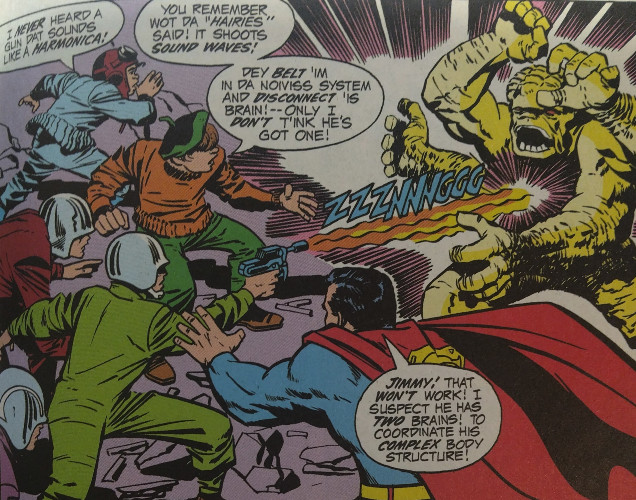
Despite its flaws, these Jimmy Olsen issues are nothing short of earnest and creative. The spirit of Jack Kirby fuels the art, story, and writing in each issue, even if some faces feel somewhat hampered by the meddling of Kirby's superiors. We get a whole lotta Kirby imaginativeness and the briefest taste of the epic he's planning. It's an unlikely pairing, the masterful Kirby and a series focused on Superman's best buddy, but Kirby has the talent and passion to make it work. Some of the story beats and characters show their age from a modern perspective, but most of the negative aspects found here are courtesy of people not named "Jack Kirby." What's most impressive is that ideas here which shouldn't work–including a society of countercultural motorcyclists, tiny clones outfitted as soldiers, and a homegrown alien created from human DNA–feel appropriately used. Characters may react dumbfoundedly to the silliness of it all, but they soon come to accept the strange absurdity in these issues, as do we…or, at least, I do. It works. It shouldn't, but it does.